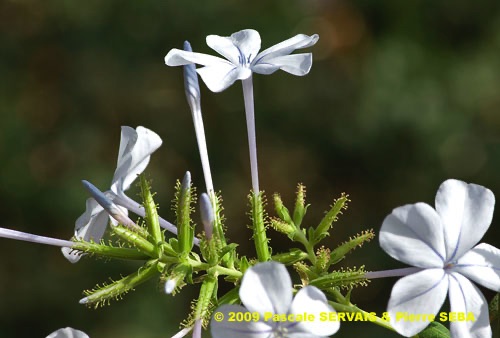
Plumbago auriculata L.
Fam. : Plumbaginaceae
© Pascale SERVAIS & Pierre SEBA, 2018. Tilo Botanica: Flore de Tilos et du Dodécanèse / Flora of Tilos and of the Dodecanese
English translation by Brenda Bradbury, Howard Bradbury and Stéphane Léonard
Arbuste hermaphrodite, à tiges grimpantes ou buisson à rameaux retombants, cannelés, glabres. Plante originaire d’Afrique du Sud.
Feuilles alternes, simples, lancéolées à elliptiques ou ovales, semi-persistantes, entières, glabres, de 5 cm de long et de 2 cm de large, à pétiole court, à face inférieure couverte de petits grains blancs.
Fleurs à symétrie radiaire, blanches à bleu pâle, de 15 à 25 mm de diamètre et de 35 à 40 mm de long, réunies en panicules denses qui s’allongent progressivement. Corolle à 5 pétales soudés en long tube très mince, à lobes étalés. Calice à 5 sépales soudés en tube, à poils glanduleux. Ovaire supère.
Fruits, capsules à une seule graine couverte de poils collants.
___________________________
Treelet hermaphrodite, with climbing stems or bush with hanging down branches, grooved, glabrous. Plant native to South Africa.
Leaves alternate, simple, lanceolate to elliptic or ovate, semi-persistent, entire, glabrous, of 5 cm long and 2 cm across, with a short petiole, with the lower surface covered in small white grains.
Flowers radially symmetrical, white to pale blue, from 15 to 25 mm in diameter and from 35 to 40 mm long, joined together in dense panicles which lengthen gradually. Corolla with 5 petals fused in a long, very thin tube, with spread out lobes. Calyx with 5 sepals fused in tube, with glandulous hairs. Ovary superior.
Fruits, capsules with only one seed covered in sticky hairs.
Descripteurs / Identifying features
1

2
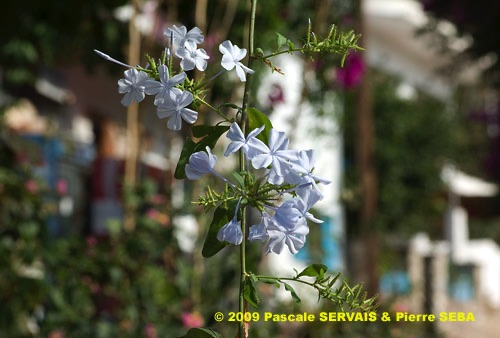
3

4
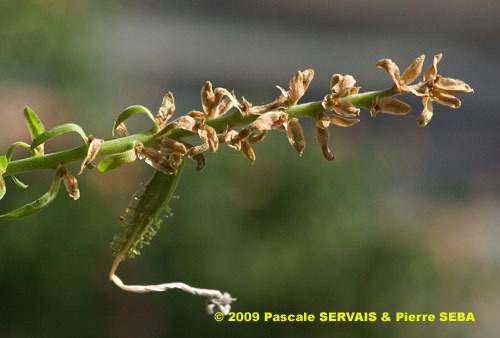
5
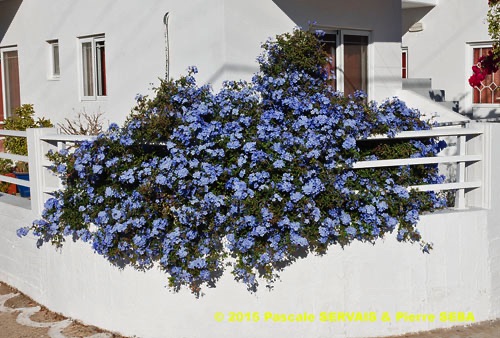
6
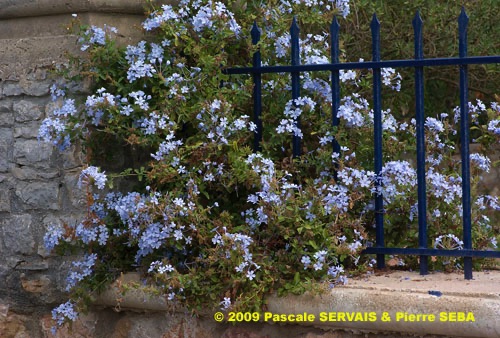
7
Étymologie / Etymology :
Plumbago : emprunt du latin plumbago, -inis (nom) = le plomb, la couleur
de plomb, la dentelaire (plante), nom donné à la plante par Pline,
naturaliste latin mort en 79 apr. J.-C., en référence à la couleur de
plomb de ses fleurs.
Auriculata : emprunt du latin médiéval auriculatus, -a, -um (adj.)
[ < auricula, -ae (nom) = la petite oreille ] = qui a de petites oreilles,
en forme d’oreille, en référence à la forme des fleurs.
Plumbago : borrowed from Latin plumbago, -inis (noun) = lead, colour of
lead, dentelaire (plant), name given to the plant by Plinius, Latin
naturalist died in 79 AD, referring to the lead-coloured flowers.
Auriculata : borrowed from medieval Latin auriculatus, -a, -um (adj)
[ < auricula, -ae (noun) = small ear ] = which has small ears, in shape
of ear, referring to the shape of the flowers.
Synonymes / Synonyms :
Plumbagidium auriculatum (Lam.) Spach
Plumbago capensis Thunb.
Noms vernaculaires / Common names :
Nom français / French name :
Dentelaire du Cap.
Nom grec / Greek name :
Μολυδβαίνα του ακροτηρίου.
Nom anglais / English name :
Cape leadwort.
Nom allemand / German name :
Kap-Bleiwurz.
Noms espagnols / Spanish names :
Jaramí blau — Jazmín azul — Jazmín del cielo — Llàgrimes —
Lleganyes — Llessamí blau — Malvesc.
Nom italien / Italian name :
Caprinella sudafricana.
Habitat :
Jardins.
Gardens.
Île / Island :
Tilos.
Hauteur / Height range :
De 1 m à 5 m.
From 1 m to 5 m.
Floraison / Flowering time :
De juin à novembre.
From June to November.
Groupe / Classification :
Dicotylédones.
Dicotyledons.
Pérennité / Lifespan :
Vivace.
Perennial.
Description :
Photo 1 :
Localisation / Location : Tilos, Megalochorio, Village
Date : 14/10/2009
GPS : Lat. 36,45497° N / Long. 27,34642° E / Alt. 79 m
Type : Photographie numérique / Digital Photograph (10 mégapixels)
Photo 2 :
Localisation / Location : Tilos, Megalochorio, Village
Date : 14/10/2009
GPS : Lat. 36,45497° N / Long. 27,34642° E / Alt. 79 m
Type : Photographie numérique / Digital Photograph (10 mégapixels)
Photo 3 :
Localisation / Location : Tilos, Megalochorio, Village
Date : 14/10/2009
GPS : Lat. 36,45497° N / Long. 27,34642° E / Alt. 79 m
Type : Photographie numérique / Digital Photograph (10 mégapixels)
Photo 4 :
Localisation / Location : Tilos, Megalochorio, Village
Date : 14/10/2009
GPS : Lat. 36,45497° N / Long. 27,34642° E / Alt. 79 m
Type : Photographie numérique / Digital Photograph (10 mégapixels)
Photo 5 :
Localisation / Location : Tilos, Megalochorio, Village
Date : 14/10/2009
GPS : Lat. 36,45497° N / Long. 27,34642° E / Alt. 79 m
Type : Photographie numérique / Digital Photograph (10 mégapixels)
Photo 6 :
Localisation / Location : Tilos, Livadia, Village
Date : 17/11/2015
GPS : Lat. 36,41358° N / Long. 27,38456° E / Alt. 12 m
Type : Photographie numérique / Digital Photograph (24 mégapixels)
Photo 7 :
Localisation / Location : Tilos, Megalochorio, Plaine d’Erystos
Date : 24/10/2009
GPS : Lat. 36,43479° N / Long. 27,34935° E / Alt. 10 m
Type : Photographie numérique / Digital Photograph (10 mégapixels)

Google Maps
Google Maps
Google Maps
Google Maps
Google Maps
Google Maps
Google Maps